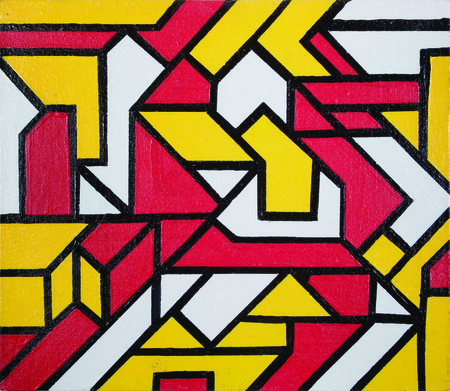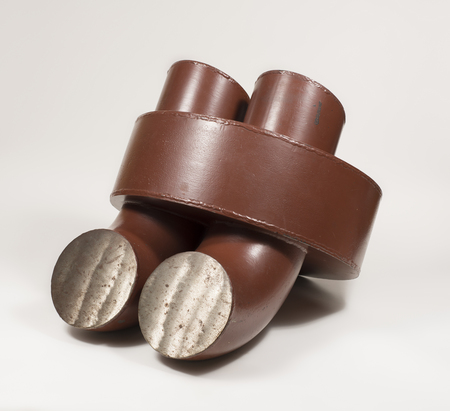EMU's 'Subverting Modernism' exhibit offers fascinating look at Cass Corridor art

"Untitled (Red, Yellow and Black Grid)" by Robert Sestok
courtesy of Eastern Michigan University
For one thing, it’s quite out of the ordinary for any metropolis outside of the acknowledged centers of American art —New York, Chicago and Los Angeles— to crystallize a consistent reinterpretation of our country’s aesthetic heritage. But Detroit’s Cass Corridor did precisely that through this period of time.
The Cass Corridor took one of the dominant 20th century American aesthetics (namely 1950-60s post-painterly abstraction) and fruitfully critiqued it while also simultaneously integrating these insights with the late-1960s through 1980s proliferation of other art “isms” (for example, environmental art; optical Art; and minimalism). This makes the Cass Corridor one of the more remarkable stories in contemporary American art history.
But EMU Art Historian Julia R. Myers; Wayne State University Art Collection Coordinator Sandra Schemske; and Central Michigan University University Art Gallery Director Anne Gochenour have done far more than merely illustrate the subversion of modernism.
They’ve resurrected a first-rate chapter in the history of American art with their Cass Corridor display. And they’ve done it up right, Detroit-style: brash talent slugging it out with insights and materials in a corner of the country where one might not expect such assured integration.
Frankly, work of this quality has only converged briefly a few times in the history of art. For Cass Corridor was not merely a school of art. It was, more accurately, a loose affiliation of like-minded artists whose talent created an artistic pluralism that defined a generation. And as “Subverting Modernism” illustrates, this kind of happy coincidence is far more easily interpreted (and misinterpreted) than actually defined.
As for the district itself, the Cass Corridor is generally defined as running parallel with Detroit’s Woodward Ave.; roughly north to Wayne State University and south to Grand River Avenue. The area includes the Cass Park Historic District and the Cass-Davenport Historic District. The area was (and still is) filled with artists, art studios, and art galleries whose Great Lakes State camaraderie has sustained this community through the last half-century of economic rough and tumble. The intellectual hub was Wayne State.
Cass Corridor artists back in the day included Keith Aoki, James Chatelain, Jim Crawford, Stan Dolega, John Egner, Georg Ettl, Steven Foust, Brenda Goodman, Michael Luchs, Gordon Newton, Ellen Phelan, John Piet, Nancy Pletos, Paul Schwarz, and Robert Sestok.
Each artist is represented in the show, and a quick perusal of the list shows us a range of talent that was as sophisticated as anywhere elsewhere nationally at that time—with each artist engendering a creativity that’s still fresh today.
The show can thus be approached from one of two viewpoints: These artists can be seen as grappling with the implications of modernism through the flat surface, painterly, and geometric implications of post-painterly abstraction or they can be seen as pointing the way to post-modernism — all with the discernible industrial grit that marks it as Michigan-born.
The exhibit is divided into eight sections: “”The Critique of Pure Painting and Sculpture”; “Minimalism/Industry”; “Complexity”; “Violence, Destruction, Decay … and Renewal”; “Vulnerability”; “Shelter”; “Music/Dance/Industry”; and “Nature/Geometry.” These sections seem to speak of Detroit’ rough-hewn character.
But as Myers says in her introduction the exhibit, truth is always a bit more complicated than it seems. As she notes, “not everyone was signing onto this (rough-hewn) interpretation. The characterization of the Cass Corridor artists as tough guys making tough art about a deteriorating and sometimes violent city was ‘journalistic crap,” according to group member John Egner.” Well. This is putting it succinctly — if not also accurately.
After all, if journalism is the first draft of history, then regional art critics at that time had to go with what seemed to be the case. It’s only in retrospect, through Meyers' marvelously meticulous historical recasting, that the Cass Corridor can be seen in its more proper context.
Side to side at the EMU Gallery’s entrance are two works that show the intellectual and ready-to-hand nature of Cass Corridor art.
-thumb-450x514-138707.jpg)
"Untitled (green triangle)" by John Egner
Perhaps Michael Luchs’ 1976 “untitled” wall-mounted assemblage (crafted from varied repurposed metals, marker, paint, screen, wire, wood, plastic, and resin) fits the bill of rough-and-tumble Detroit art. Luchs’ massive sculpture — with its burns, abrasions, and cuts indiscriminately set against his menage of found elements — could arguably represent a sort of post-industrialism gone to seed. But this is also questionably reading into this particularly energetic aggregate of nontraditional found materials, whose offhanded quality reflects surface articulation rather than overt meaning.

"Untitled" by Stan Dolega
Meyers accurately sums up the mid-20th century inner-city Detroit art situation when she writes, “While the Cass Corridor artists often saw each other daily and worked and sometimes even lived side by side in the area’s studio complexes, they did not, however, develop a unified style. Instead, each artist created his or her own individual style and meanings, which were cross-fertilized at times by his/her fellows.
“What does unify these artists is their reference to, but rejection of, the tenets of Modernism, which held sway, but were increasingly under attack, in the New York art circles in the 1960s and early 1970s. Thus these artists participated in the movement from Modernism to Post-Modernism that took place in American art in the 1970s.”
So there may be other ways of saying these Detroit artists were challenging the dominant American aesthetic of their time; but as Myers aptly phrases it, “subverting” fits just about right. Indeed, the word has more than a bit of Detroit bite.
“Subverting Modernism: Cass Corridor Revisited 1966-1980” will continue through April 28 at the Eastern Michigan University Student Center University Gallery, Room 210, 900 Oakwood St., Ypsilanti. Gallery hours are 10 a.m.-5 p.m. Monday and Thursday; 10 a.m.-7 p.m. Tuesday-Wednesday; and 10 a.m.-2 p.m. Friday-Saturday. For information, call 734-615-0624.


Comments
Jim Pallas
Mon, Sep 2, 2013 : 3:45 p.m.
Finally, some unbiased eyes- Myers and Gochenour - might be chipping away at the tidy definition of Cass Corridor art connived so long ago by dealer Jackie Feigenson and the D.I.A."s Sam Wagstaff. Go get 'em, kids.
sttc
Wed, Apr 3, 2013 : 8:28 p.m.
not strictly true; the "intellectual hub" of the cass corridor was at least as much the college of creative studies as it was wayne state. but thank you for bringing this show to my attention with this excellent article. if anyone else out there is interested in learning more about this intriguing period in the cultural history of detroit, there's a great web site called tribes of the cass corridor: http://www.corridortribe.com/index.html
PattyinYpsi
Wed, Apr 3, 2013 : 1:32 p.m.
I would never have known that this show was going on if it weren't for this article, so many thanks! I'll be sure to check it out before the end of the month. And John Carlos, another beautifully written and enlightening article. I'm a big fan of your work!
Laurie Barrett
Wed, Apr 3, 2013 : 12:39 p.m.
Looks like an excellent show! Thanks EMU